AC/AC Converters – Changers
A switching converter that changes an AC supply to the AC supply with a different voltage, frequency, phase, or shape is called an AC/AC converter or changer. The first group of such converters unifies the direct frequency converters that change the frequency and AC voltage shape. Another group joins the DC link frequency converters where a rectifier is used as a voltage regulating or a constant-voltage front-end system whereas an inverter generates an AC voltage of a certain frequency and magnitude.
Cycloconverters
Cycloconverters are naturally commutated direct frequency converters that are synchronized by a supply line. Commonly, they are allowed in high-power applications up to tens of megawatts for frequency reduction. A thyristor closing by means of natural commutation, i.e. turned off on zero current, is almost the only device that can meet the switch voltage and current rating needed at these power levels. 3-, 6-, 12-, and 24-pulse cycloconverters are used.
Cycloconverter topology can be subdivided into two types: direct single-step cycloconverters and indirect two-step cycloconverters.
Figure 1, a, shows the single-phase indirect cyclo converter. Its left and right sub-converters are the supply-side and the load-side controlled rectifiers, respectively, which may operate both in a rectifier mode and in an inverting mode. A reference signal, which drives the thyristor gates, specifies the frequency, the polarity, and the amplitude of the output voltage Us load. This means that the firing angles of the two sub-converters depend on this reference. As Fig. 1, b, c, d show, the output frequency amounts only to the part of the input frequency (the case when the fundamental output frequency is one-third of the input frequency is shown) while the firing angle changes between the minimum and the maximum possible values, depending on the reference magnitude. Particularly, in Fig. 1, b, the firing angle a is of minimum value. The waveform of the output voltage at a reduced value of the reference is shown in Fig. 1, c. If the reference varies with time during each half-cycle instead of remaining constant, the firing angles change during the half-cycle also. This reduces the harmonic content in the output voltage, as Fig. 1, d shows.
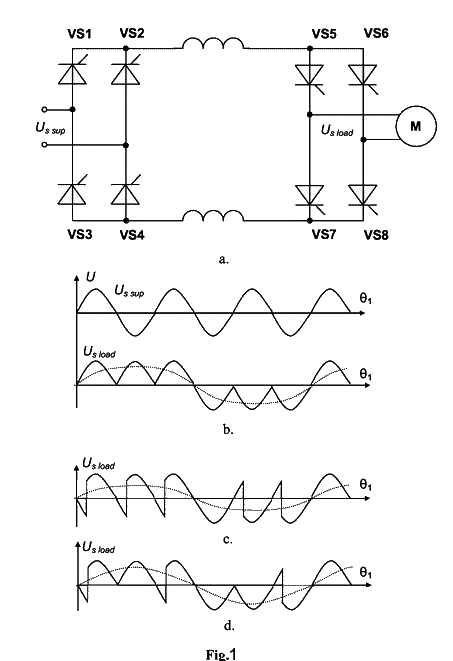
The cyclo converter provides full four-quadrant operation. To obtain the positive voltage passing the positive current in the first quadrant of the current-voltage plane, switches VS5 and VS8 are kept open, VS6 and VS7 closed, while switches VS1 with VS4 and VS2 with VS3 rectifier voltage by adjusting the firing angles in the range 0 to 90°. To obtain the negative voltage passing the positive current in the fourth quadrant, switches VS5 and VS8 are still open but switches VS1 with VS4 and VS2 with VS3 go to the inverting operation by adjusting the firing angles in the range 90° to 180°. To insure the negative voltage passing the negative current in the third quadrant, switches VS6 and VS7 are open, VS5 and VS8 closed, while switches VS1 with VS4 and VS2 with VS3 rectifier voltage by adjusting the firing angles in the range 0 to 90°. To ensure the positive voltage passes the negative current in the second quadrant, switches VS6 and VS7 are still open whereas switches VS1 with VS4 and VS2 with VS3 go to the inversion.
The circuit diagram of a 6-pulse indirect cyclo converter is represented in Fig. 2. The device has a three-phase input and a single-phase output and consists of two anti-parallel three-phase bridges. Thyristors are closed thanks to the natural voltage commutation. To obtain a bilateral load current, a “negative” converter, which carries a negative current, is placed in parallel with the “positive” one. Such a combined circuit is known as a naturally commutated four-quadrant cyclo converter.
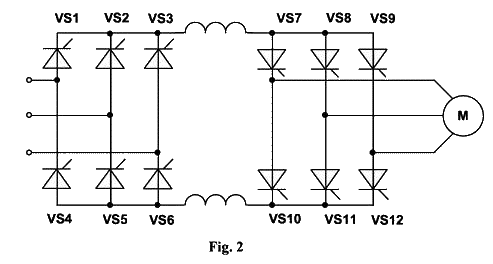
The converter produces an AC output voltage for the bi-directional output current. To obtain the positive voltage and pass the positive current in the first quadrant of the current-voltage plane, switches VS1 and VS6, then VS2 and VS4, and next VS3 and VS5 rectifier voltage by adjusting the firing angles in the rectifying range. To ensure the negative voltage passes the positive current in the fourth quadrant, the same switches go to the inverting operation by adjusting the firing angles in the inverting range. To pass the negative current, the two bridges change their roles so that VS7 ... VS12 performs firing adjusting instead of VS1 ... VS6.
The firing angles are adjusted so that the output voltage is kept close to the sinusoidal form. For smooth commutation of the current from one bridge to another, the firing angle is momentarily changed above 45° and the bridge goes into the inverter operation mode.
Unfortunately, the frequency of the output voltage cannot precede the frequency of the supply voltage and is always at least twice less. Moreover, the large number of thyristors seems at first sight staggering. For the six-pulse converter with a three-phase output shown in Fig. 3, a minimum of 36 thyristors is required. This indicates that cyclo converters are mainly of interest for large systems, where parallel thyristor branches would be necessary in other converter circuits.
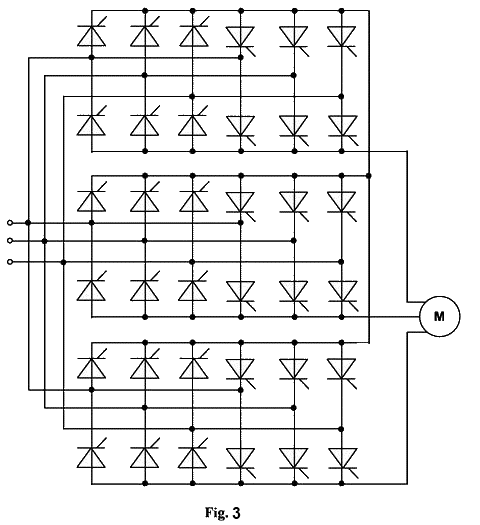
One popular circuit of the direct frequency converter is given in Fig. 4. This three-phase cyclo converter incorporates three three-pulse midpoint dual-controlled sub-converters that create three output voltages. Each sub-converter has six thyristors, three to carry the positive load current and three to carry the negative one. A transformer with a three-phase secondary winding is used for the thyristors supply. There is no difference in whether the load is active or passive because operation in all four quadrants is possible.
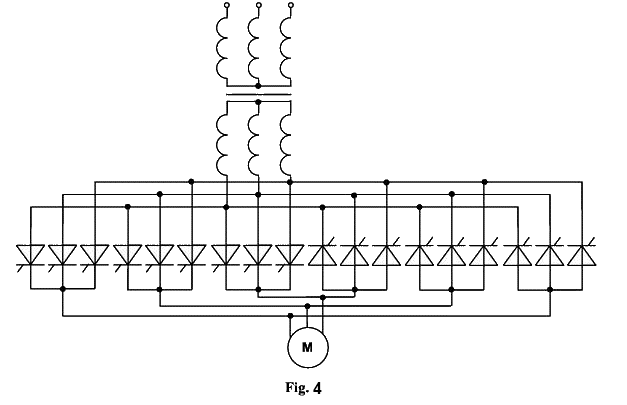
Since the output voltages are assembled from the sections of the line voltages here, as the output frequency rises, the output voltages track the sinusoidal references with increasing errors and consequent distortion. The frequency range
0<f<mf1/15
is usually considered as the useful range of operation, where f1 is the line frequency and m is the number of pulses. With a 50 Hz net and a three-phase circuit (m = 6), this results in fmax = 20 Hz. Clearly, if a three-phase line of higher frequency is available, the range of output frequency is extended accordingly; this may be the case for vehicles or ships when a diesel- or turbine-driven generator provides onboard power.
When considering the effects of a converter on the line-side currents, it is helpful to remember that a symmetrical three-phase system of sinusoidal voltages and currents results in constant net power. Since the cyclo converter contains only switches but no storage devices (apart from the unavoidable leakage inductances, protective circuits, etc.), the total three-phase input power corresponds to the output power. Nevertheless, there will be reactive power on the line side, which is inherent in the control of the line-commutated converters by delayed firing.
Matrix frequency converters
Converters built on the bi-directional, bipolar switches are called matrix converters. Like the cyclo converters, they provide a direct power flow between the n-phase AC source and the m-phase load. They are more compact, light, and versatile than other converter solutions. Matrix converters allow for achieving higher levels of integration, broad output frequency and voltage range, higher temperature operation, and natural bi-directional power flow suitable to regenerate energy back to the utility.
Again, the matrix converter topology can be subdivided into two types: direct converters and indirect converters. The latter are also referred to as dual-bridge, sparse, or two-stage matrix converters.
A generalized circuit diagram of a direct matrix converter with three-phase input Us sup and three-phase output Us load is shown in Fig. 5, a. Its power section consists of bi-directional, bipolar switches between each of the input and each of the output phases. In this crossbar arrangement, three load terminals are alternately connected to the three supply terminals. The maximum frequency is only constrained by the capabilities of semiconductor switches. However, the phase angle between the voltages and currents at the input can be controlled and does not have to be the same as at the output. In addition, the waveform and the frequency at the two sides are independent. Commutation strategies require that those switches – at least in certain time spans – be turned on only for one current direction while maintaining blocking capability in the opposite sense.
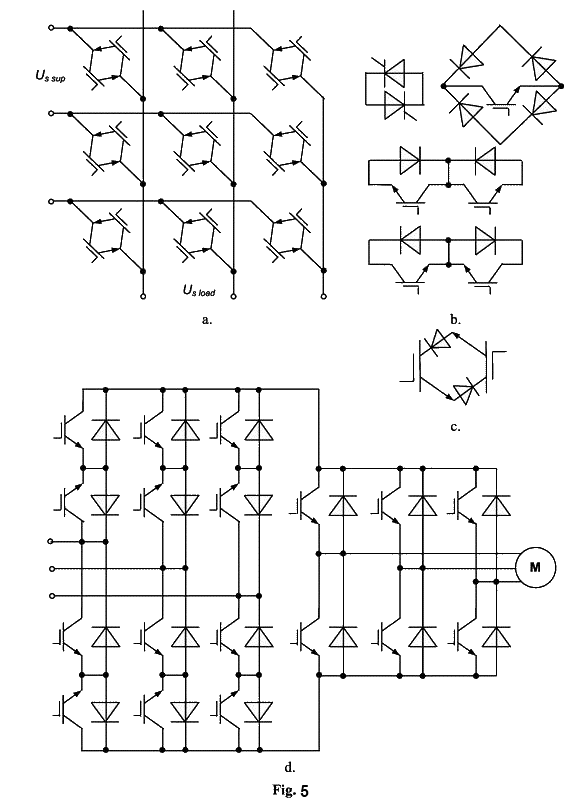
The switches in a matrix converter must be bi-directional, that is, they must be able to block voltages of either polarity and to conduct current in either direction. This switching strategy permits the highest possible output voltage; at the same time, the reactive line-side current is reduced since the current flows only in the center region of the line voltage periods. Typically, bidirectional, bipolar switches in a matrix converter operated at main voltage levels are composed of a connection of two switching elements. These topologies permit separate control in both current directions. With this general arrangement of switches, the power flow through the converter is reversible. Because of the absence of any energy storage elements, the instantaneous power input may be equal to the power output, assuming idealized zero-loss switches. As far as this converter provides an output voltage directly from the multi-phase network voltage, the pieces of the input voltage conduct to the outputs at appropriate instants. That is why the output voltage of the required frequency, number of phases, phase, amplitude, etc. is generated and can be freely varied in a wide range.
The described matrix converter is simple in structure and has powerful controllability but the commutation problem and complex control keep it from being broadly utilized in industry. Theoretically, the switching sequence in the matrix converter must be instantaneous and simultaneous; unfortunately, it is impossible for practical realization due to the turn-off IGBT characteristic, where the tailing-off of the collector current will create a short circuit with the next switch turn-on. This problem is typical for the inductive load character that a motor has, therefore switching results in current and voltage spikes that may destroy the switches due to stress.
These converters need a great number of bi-directional switches to connect input and output lines. As very fast bi-directional power switches are almost not available yet, they are realized by a combination of switches. The back-to-back connection of two IGBTs shown in Fig. 5, a, offers independent control of the current in both directions and can be implemented using standard components available in a large range of current and voltage ratings. As practically these switches are implemented by combining several unidirectional switches, a high number of power devices (diodes and transistors) are required. The interconnection of all these devices is a complex task due to high current and voltage spikes and overshoots produced by the power circuits, as well as the high number of control signals to be managed in a noisy environment. Reverse-blocking transistors are an emerging alternative to silicon in the current path. However, additional gate circuitry is required since the two emitters are not tied to the same potential.
Capacitive filters can remove the high-frequency components of the line currents. There are also limits on the ratio of the input and output magnitudes. Any solution oriented to avoid these problems is welcomed by the design engineers. That is why different safe commutation strategies have been developed by many manufacturers to overcome the problem. A number of other building blocks were suggested, some of which are shown in Fig. 5, b.
Sometimes, two anti-parallel connected thyristors can be used. Using a single transistor rounded by the bridge rectifier offers cost advantages with a simple control. However, a low-latency current detector is required by this circuit since the switch does not allow for natural turn-off. At higher frequencies, a switch built on fast IGBTs and freewheeling diodes should be used. These topologies permit separate control in both directions of the current flow. In the common collector configuration, only one power supply per input and output of the matrix topology is needed, however, separate drivers for IGBTs are required. In contrast, in a common emitter configuration, the drivers of each switch have to use an isolated supply; however, one driver for both IGBTs is sufficient if separate control of the current direction is not required.
Another approach is to use the novel semiconductor device – reverse blocking IGBT. It behaves like an IGBT but provides blocking capability for applied reverse voltage. An anti-parallel connection of two of those devices according to Fig. 5, c, operates as a bi-directional, bipolar switch. Both directions of current flow can be controlled separately here. In a matrix converter, one driver would be needed for each reverse blocking IGBT, and one supply for the drivers of all devices connected with the emitter to the same input or output line.
Unlike the direct matrix converters, Fig. 5, d, proposes the sparse indirect matrix converter with the same functionality, but using separate input and output sections, connected by a DC link without storage elements. This design includes a four-quadrant current source rectifier and a voltage source inverter. The input section consists of bi-directional bipolar switches, whereas the output section has a conventional bridge topology, as known from VSI. A three-phase system operated at the mains voltage levels, it typically consists of three-phase legs with two IGBTs with anti-parallel freewheeling diodes in both legs. A commutation strategy can be applied, changing the switching state of the input section while the output section is in a freewheeling mode. Thus, switching off the input section can be performed at zero current, which facilitates safe commutation and reduces switching losses to a minimum. The Turn-on state of the bi-directional bipolar switches needs not to be separately controllable for the two directions of the current flow. This commutation algorithm is of significantly less complexity and higher reliability as compared to a conventional direct matrix converter.
DC link converters
Converters with a DC voltage link circuit are the most common contemporary solution because of their wide area of applicability. They can be used for individual or multiple load applications in all fields of machine building and construction, mainly where the emphasis is on load-independent stability, maintenance-free operation, and high efficiency. Due to the characteristic of the impressed voltage in the DC link, the converters are stable in overload and no-load modes and can be disengaged from the load without damage. Usually, they come standard as 1-, 2- and 4-quadrant operation since the corresponding accessories are employed. A variable three-phase output voltage of such converters commonly rises up to the level of the input voltage and higher with a proportionally rising output frequency of 0,1...10 to 120...400 Hz.
Fig. 6 presents the frequency converter having a non-controlled mains rectifier, a DC link, and an inverter. The front-end rectifier VD1 ... VD6 converts the three- or optionally also single-phase AC on the input terminals to a DC voltage, being proportional to the AC voltage in the order of magnitude of several hundreds of volts. This level is the reason why the following transistorized stages almost exclusively use IGBT or FET transistors with appropriate fast freewheeling diodes.
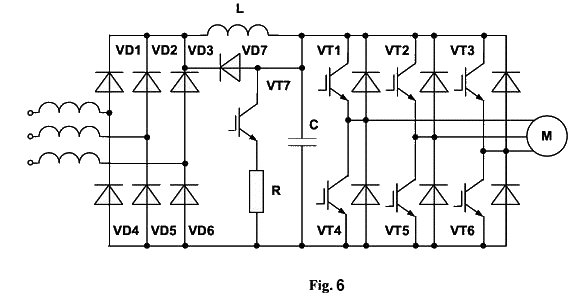
Traditionally, the front-end bridge rectifier is connected to the supply line through the chokes or the transformer to defend the mains from the non-linear distortions of the converter. Between the front-end rectifier and the transistorized stage, an inductor (or choke) L may be inserted to protect and optimize the converter behavior. The ripple of the rectifier output voltage has a low-value thanks to filtering by this smoothing inductor, which reduces the pulse spikes and limits the fault currents. Sometimes, the freewheeling diode VD7 shunts the inductor to decrease its influence when the switches are off.
The large electrolytic compensative capacitor C protects the DC link from overvoltages. It “stiffs” the link voltage and provides a path for the rapidly changing currents drawn by the inverter. In some circuits, this capacitor is shunted by an additional RC circuit, which decreases the high-frequency obstacles. Once the converter is switched on, the capacitor charges. This way, the circuit startup current is limited. The capacitor permits the DC current to be temporarily raised or lowered during the commutation of the load-side inverter under the constant voltage.
Inverter switches VT1 ... VT6 supply the load with the required AC voltages. By adjusting the transistor inverter circuit, the unidirectional link current and bi-directional voltage allow the use of a two-quadrant operation where the reverse power flow is achieved by the transistor control.
To provide the braking operation in the four-quadrant mode of the load, the inverter feeds recovered electrical energy to the DC link. For that, the feedback diodes across the transistors provide an alternate path for the inductive current when the switches are turned off. The diodes return the regenerating power to the dc link, which will raise the link voltage above its normal value and measures must be taken to absorb this regenerated power to prevent a dangerous link voltage buildup.
Typically, to prevent DC voltage from exceeding capacitive storage element ratings, the special brake chopper VT7 connects a braking resistor R across the DC link capacitor C to absorb and dissipate energy. Usually, the brake chopper switches automatically on when the DC link voltage reaches a certain level.
Further, the shunts or the current transducers may be applied between the rectifier and the braking chopper or inverter as well as between the inverter and the load, depending on the concept of the control hardware. These sensors influence the transistor adjustment depending on the current value thus improving performance, safety, and cost.
Due to the diode front-end rectifier, the circuit has some disadvantages:
- The AC line current waveform is non-sinusoidal, therefore the high level of interference can penetrate other equipment and disturb their normal operation
- The harmonic current distortion results in a distortion of the voltage and can affect the performance of other consumers connected to the power supply system
- Such circuit cannot operate in the machines with frequent startups, braking, and current direction change
An active front-end rectifier can provide a solution for a majority of these problems. A converter with an active rectifier, shown in Fig. 7, can transfer energy in either direction, depending on the switching sequence. The circuit diagram of the rectifier is similar to that of an offline inverter, but it operates as a converter synchronized by the supply line. In the motoring mode, when the load acquires the supply power, the active rectifier passes the currents through the diodes whereas the inverter passes the currents through the transistors. In the braking mode, the inverter turns into the rectifier mode, passing the currents through the diodes, whereas the rectifier becomes an inverter and passes the currents through the transistors. Thus, the advantage of this circuit is that it allows a flexible bidirectional energy transition to and from the load back to the power supply line. A simple energy redirection results in implying the symmetrical circuit, adjusting the power factor to the unity or negative values, and supporting a wide range below and above the supply frequency. For correct operation, it usually requires some minimum value of inductance in the line to avoid damage during switching. Line chokes may need to be added if a supply has a high fault level and low source impedance.
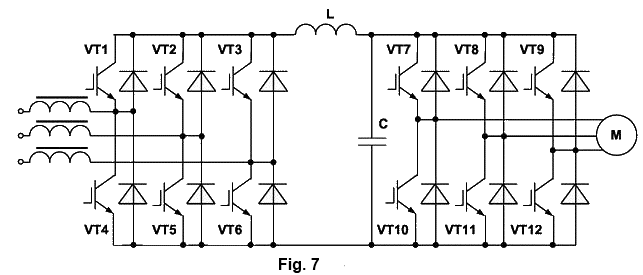
Summary
Equipment that converts AC of one frequency to another frequency is known as a frequency changer. A cyclo converter is the most popular changer that permits direct transformation from AC to AC by appropriate switching and natural commutation of the control devices. Cycloconverters are used in high-power applications to decrease the supply frequency of such low-speed machines as rolling mills, hoists, excavators, and screw propellers. They do not contain energy storage in the intermediate circuit. Thanks to the direct conversion of the input to the output power, they are very effective. The commonly used direct frequency converters are naturally commutated cyclo converters, but their disadvantages manage the low-frequency output, which cannot be higher than 0,4 of the supply frequency. The power factor of the cyclo converters is low also.
Because of the absence of any energy storage elements, in the matrix converters, the instantaneous power output approaches the power input, thus providing the highest efficiency. The application fed by a matrix converter is superior to other inverters because of the lack of bulky reactive components with limited lifetime, the bi-directional power flow capability, the sinusoidal input and output currents, and the adjustable input power factor. Furthermore, because of the high integration capability and the higher reliability of semiconductor structures, the matrix converter topology is recommended for extreme temperatures and critical volume/weight applications. In the motor drives, the braking resistors are not required, since the power flow during braking can be reverted, leading to a regenerative operation. However, a few practical matrix converters have been applied because the implementation of switch devices is sufficiently difficult and the control technique is more complicated than with the conventional inverters. Converter nonlinearities, together with the sensor offsets, could affect the estimation of the voltage applied to the load. The limited voltage transfer ratio and the high number of power semiconductor devices required restrict their usage.
Today, AC/AC converters with a DC link have the broadest use. The minimum power of such converters is measured by watts, whereas the maximum may approach megawatts. The best models transfer energy in either direction, depending on the circuit arrangement and switching sequence. Nevertheless, a sufficiently high level of voltage distortion affects the performance of other equipment connected to the power supply system. Due to the use of an electrolytic capacitor between the two energy conversion stages, the design of the converter is bulky while efficiency is limited by the losses in series-connected electronic devices.
Whether AC power is supplied to an AC inductive load by a DC link conversion or by a direct AC conversion, the output voltage wave is not sinusoidal. This is the common drawback of all types of AC/AC converters.
Affiliate Links
